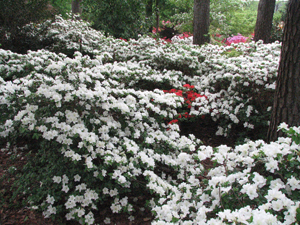Resource Library
Plant of the Week: Pleasant White, Girard's Azalea
The University of Arkansas System Division of Agriculture does not promote, support or recommend plants featured in "Plant of the Week." Please consult your local Extension office for plants suitable for your region.
Plant of the Week
Pleasant White, Azalea Girard's

The azaleas have been blooming in my garden for several weeks now and, with each pass through the collection, I discover a new favorite such as ‘Pleasant White’. The 60 or so different azaleas I grow is but a small smattering of the many thousands of cultivars Fred Galle lists in his 1987 book Azaleas (Timber Press, Portland). Since the publication of this tome, the Encore azaleas have been introduced and the commercial azalea world has been reshaped to reflect this class of repeat bloomers and new developments in push-through marketing to consumers.
‘Pleasant White’ is one of the Girard evergreen azaleas that makes a 5-to 6-foot tall and wide shrub if allowed to grow to its full stature. Unlike its parent ‘Kathy Ann’, another white flowering Girard hybrid that has a broad spreading habit and often grows twice as wide as tall, ‘Pleasant White’ has more upright branching and works better in shrub beds.
The white, wavy-margined midseason blooms are single, non-fragrant and 2.5 to 3 inches across. Plants tend to be heavy bloomers and bloom well each year.
Peter E. Girard Sr. began breeding azaleas in 1946 in the Lake Erie region of Ohio with a goal of creating large-flowered, winter hardy azaleas for colder climates. He began working with the most cold-hardy azaleas then being grown, the Gable hybrids developed by Joseph Gable in Stewartstown, Penn. Over the next 30 years he continued to breed azaleas, using more of his own material as parents. ‘Pleasant White’ is a 1962 cross between ‘Kathy Ann’ and ‘Clare Marie’, both first generation Girard hybrids.
Girard introduced a number of his hardy evergreen azaleas in 1971. By the 1990’s they were being picked up by large wholesale nurseries that shipped them across the country. His son, Peter E. Girard Jr., continued operating the nursery in Geneva, Ohio, following his father’s death. Peter senior’s grandchildren still operate the nursery. Girard’s azaleas were neither patented nor trademarked so the breeder did not reap great financial reward from his work, but in the annals of horticulture, his work will long be remembered.
But will average gardeners be growing Girard azaleas in 50 years? Probably not, except for the plant geeks such as me who seek out specific plants to add to their collections. For a plant to have sticking power in the nursery trade it must have an advocate. Financial reward is the most common reason for a firm or individual to become a plant’s advocate and shameless promoter. Being a good plant is not enough because there are lots of good plants in the world, but only the new and highly touted are going to produce the highest profit margin.
Girard azaleas are one of the best hybrid groups for growing in hardiness zones 6 and 7. Like all azaleas, they should be planted in a mounded up bed created by amending lots of pine bark or peat moss with an existing sandy loam soil. If the existing soil is heavier than a sandy loam soil, mix equal parts of sand and pine bark and incorporate this into the top 4 inches of the soil, but leaving most of the new bed above the original soil line. Plant the azaleas so that at least half of their original root ball is above the soil line. Water the plants weekly during the summer.
Azaleas are best when planted in an area with a high, widely spaced canopy of trees. They can grow in full sun but too much sun (and heat) diminishes the length of the bloom display. Too much shade reduces the number of flowers that are set. Unpruned azaleas have a more open, natural look but will get taller than many gardeners can accommodate. If their size needs to be managed, shear the plants back just after blooming but do no additional pruning during that season. Shearing the plants in a tight ball or box, though not technically illegal, is certainly a crime against nature.
By: Gerald Klingaman, retired
Retired Extension Horticulturist - Ornamentals
Extension News - April 6, 2012
The University of Arkansas System Division of Agriculture does not maintain lists of retail outlets where these plants can be purchased. Please check your local nursery or other retail outlets to ask about the availability of these plants for your growing area.